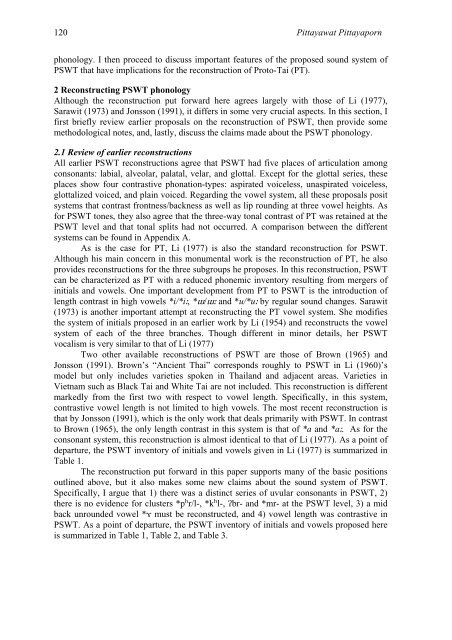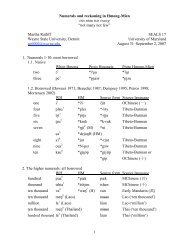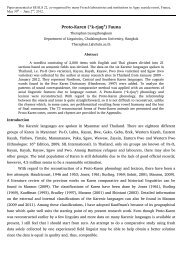proto-southwestern-tai revised: a new reconstruction - seals 22
proto-southwestern-tai revised: a new reconstruction - seals 22
proto-southwestern-tai revised: a new reconstruction - seals 22
You also want an ePaper? Increase the reach of your titles
YUMPU automatically turns print PDFs into web optimized ePapers that Google loves.
120 Pittayawat Pittayaporn<br />
phonology. I then proceed to discuss important features of the proposed sound system of<br />
PSWT that have implications for the <strong>reconstruction</strong> of Proto-Tai (PT).<br />
2 Reconstructing PSWT phonology<br />
Although the <strong>reconstruction</strong> put forward here agrees largely with those of Li (1977),<br />
Sarawit (1973) and Jonsson (1991), it differs in some very crucial aspects. In this section, I<br />
first briefly review earlier proposals on the <strong>reconstruction</strong> of PSWT, then provide some<br />
methodological notes, and, lastly, discuss the claims made about the PSWT phonology.<br />
2.1 Review of earlier <strong>reconstruction</strong>s<br />
All earlier PSWT <strong>reconstruction</strong>s agree that PSWT had five places of articulation among<br />
consonants: labial, alveolar, palatal, velar, and glottal. Except for the glottal series, these<br />
places show four contrastive phonation-types: aspirated voiceless, unaspirated voiceless,<br />
glottalized voiced, and plain voiced. Regarding the vowel system, all these proposals posit<br />
systems that contrast frontness/backness as well as lip rounding at three vowel heights. As<br />
for PSWT tones, they also agree that the three-way tonal contrast of PT was re<strong>tai</strong>ned at the<br />
PSWT level and that tonal splits had not occurred. A comparison between the different<br />
systems can be found in Appendix A.<br />
As is the case for PT, Li (1977) is also the standard <strong>reconstruction</strong> for PSWT.<br />
Although his main concern in this monumental work is the <strong>reconstruction</strong> of PT, he also<br />
provides <strong>reconstruction</strong>s for the three subgroups he proposes. In this <strong>reconstruction</strong>, PSWT<br />
can be characterized as PT with a reduced phonemic inventory resulting from mergers of<br />
initials and vowels. One important development from PT to PSWT is the introduction of<br />
length contrast in high vowels *i/*iː, *ɯ/ɯː and *u/*uː by regular sound changes. Sarawit<br />
(1973) is another important attempt at reconstructing the PT vowel system. She modifies<br />
the system of initials proposed in an earlier work by Li (1954) and reconstructs the vowel<br />
system of each of the three branches. Though different in minor de<strong>tai</strong>ls, her PSWT<br />
vocalism is very similar to that of Li (1977)<br />
Two other available <strong>reconstruction</strong>s of PSWT are those of Brown (1965) and<br />
Jonsson (1991). Brown’s “Ancient Thai” corresponds roughly to PSWT in Li (1960)’s<br />
model but only includes varieties spoken in Thailand and adjacent areas. Varieties in<br />
Vietnam such as Black Tai and White Tai are not included. This <strong>reconstruction</strong> is different<br />
markedly from the first two with respect to vowel length. Specifically, in this system,<br />
contrastive vowel length is not limited to high vowels. The most recent <strong>reconstruction</strong> is<br />
that by Jonsson (1991), which is the only work that deals primarily with PSWT. In contrast<br />
to Brown (1965), the only length contrast in this system is that of *a and *aː. As for the<br />
consonant system, this <strong>reconstruction</strong> is almost identical to that of Li (1977). As a point of<br />
departure, the PSWT inventory of initials and vowels given in Li (1977) is summarized in<br />
Table 1.<br />
The <strong>reconstruction</strong> put forward in this paper supports many of the basic positions<br />
outlined above, but it also makes some <strong>new</strong> claims about the sound system of PSWT.<br />
Specifically, I argue that 1) there was a distinct series of uvular consonants in PSWT, 2)<br />
there is no evidence for clusters *pʰr/l-, *kʰl-, ʔbr- and *mr- at the PSWT level, 3) a mid<br />
back unrounded vowel *ɤ must be reconstructed, and 4) vowel length was contrastive in<br />
PSWT. As a point of departure, the PSWT inventory of initials and vowels proposed here<br />
is summarized in Table 1, Table 2, and Table 3.





